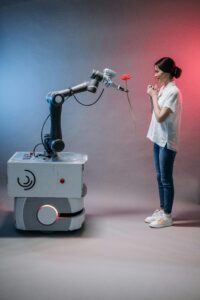introduction
The way we live, work and communicate has been revolutionized by technology. Among them, an important trend seen in recent years is the progression of robots and automation. “Robots are doing jobs humans can’t do, and even jobs humans can do are being affected by robots and automation,” says Goebel, who addressed some of the challenges and opportunities on the horizon during a Sept. 4 Oregon State University Science Pub Corvallis talk.
This article delves into that question, looking at the advantages, the concerns, and how society can tap into this automation without abandoning its human workforce.
International Federation of Robotics (IFR) – Industry reports and trends in robotics.
👉 https://ifr.org
According to the International Federation of Robotics, global robot installations hit a record high in recent years, especially in manufacturing.
Advantages of Automation and Robots
Advantages of automation are countless especially in the following aspects:
Robots never need to sleep, take breaks, or have a day, or night, off. It helps increase production in the industries and services.
- Error Minimization: Robots don’t make mistakes, at least not nearly as much as humans, reducing human errors.
- Worker Safety: Many hazardous jobs such as ones that expose workers to chemicals, mining and exposure to explosion hazards can be performed safely by robots.
- Savings: The upfront costs of automation can be significant, but long-term costs, such as wages and training, decrease.
- The Fear: Will Robots Replace Us?
There is a concern that robots will take the place of human workers. This is especially likely in:
Easy and Repetitive Tasks Simple or repetitive jobs like clean-up, packaging, basic accounting can be easily automated.
Skills That Don’t Require Creativity: Jobs that can be learned quickly are more likely to be replaced by machines.
Examples: Industries like textiles, automotive, and even customer service are increasingly relying on automation.
However, history shows that while technology may eliminate certain jobs, it also creates new opportunities. For example, when an automated factory is built, it requires engineers, programmers, and technicians for maintenance and development.
How Can Societies Benefit from Automation Without Leaving People Behind?
Training and Skill Upgrading:
Governments and private companies should offer programs to teach modern skills like programming, robot maintenance, and AI usage.
Focus on Uniquely Human Skills: Skills that machines can’t replicate—like creativity, empathy, and leadership—should be emphasized.
Establish Worker Protection Laws:
Regulations should be in place to manage job transitions and ensure people are not suddenly left unemployed.
See Automation as an Opportunity:
If used wisely, automation can provide easier lives, greater productivity, and more free time for personal development.
Conclusion
It’s true that robots and automation are changing the way people work. There are real worries about job loss, but there is also a lot of room to create new, high-quality jobs. The most important thing is to get our societies, especially young people, ready to deal with this change instead of being afraid of it. Technology is just a tool; how we use it can make it a problem or a solution.
As machines take over boring, dangerous, or routine jobs, people are needed more and more for jobs that require critical thinking, creativity, emotional intelligence, and good communication with others. There are more and more jobs available in fields like healthcare, education, software development, renewable energy, and artificial intelligence. But both current workers and future generations need to learn new skills in order to take advantage of these changes. Education systems need to change, and they should not only.
Ultimately, the question isn’t whether robots will take our jobs, but how we will evolve alongside them. With the right mindset, policies, and education, automation can lead to a more efficient, creative, and human-centered future of work—one where machines handle the repetitive tasks and humans focus on what they do best: innovate, connect, and lead.



